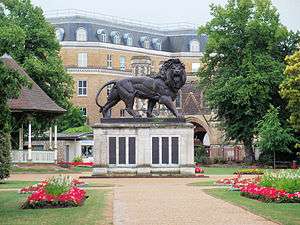66th (Berkshire) Regiment of Foot
The 66th (Berkshire) Regiment of Foot was an infantry regiment of the British Army, formed in 1758 and amalgamated with the 49th (Princess Charlotte of Wales's) (Hertfordshire) Regiment of Foot into Princess Charlotte of Wales's (Berkshire Regiment) in 1881.[1]
The regiment was raised by the redesignation of the 2nd Battalion, 19th Regiment of Foot in April 1758, ranked as the 66th Regiment of Foot. In 1782 they took a county title as the 66th (Berkshire) Regiment of Foot.
History
In 1764 the regiment was posted to Jamaica to relieve the 49th Regiment and then fought during the Peninsular War of 1803, gaining many battle honours. In 1816 it was sent to St. Helena to guard Napoleon after his defeat at Waterloo and in 1821 the grenadiers of the 20th Foot and the 66th Foot carried his body at his funeral. The regiment afterwards returned to England and had postings to Gibraltar and the West Indies.[2]
Battle of Maiwand
The regiment took part in the 1880 Battle of Maiwand where the bravery of the English soldiers astounded the Afghans. The British had effectively lost the battle, and the Indian regiments fighting alongside the 66th were routed in disorder from the battlefield. Some men of the 66th were caught up in the rout, but most of the remaining members of the regiment gathered around Lt Colonel Galbraith and fought a rearguard action to protect the retreating Indian soldiers. 140 of them made a stand at the Mundabad Ravine, which ran along the south side of the battlefield, but were forced back with heavy losses. The Queen's Colour and the Regimental Colour became a focus of attention, and several officers and NCOs were killed trying to keep the Colours aloft.
Eventually 56 survivors made it to the shelter of a walled garden and made a further stand, while a few more ran to follow the retreating Indian soldiers. Eventually the 56 were whittled down to only 11 men—two officers and nine other ranks. These last eleven survivors charged out of the garden and fought, first with rifle fire and then with bayonets when they ran out of bullets, until they were overcome. An Afghan artillery officer described their end: "These men charged from the shelter of a garden and died with their faces to the enemy, fighting to the death. So fierce was their charge, and so brave their actions, no Afghan dared to approach to cut them down. So, standing in the open, back to back, firing steadily, every shot counting, surrounded by thousands, these British soldiers died. It was not until the last man was shot down that the Afghans dared to advance on them. The behaviour of those last eleven was the wonder of all who saw it" Officers who died in the last stand in the garden included: Captain Walter Roberts, Lieutenant Maurice Edward Rayner, Second Lieutenant Walter Rice Olivey and Second Lieutenant Arthur Honywood.[3] Lieutenant Richard Trevor Chute, who had been ferrying ammunition to the soldiers, was not seen in the garden by any of the survivors, and although he may have been killed there, it is also possible that he was one of the last eleven. The only officer who can definitely be identified as one of the eleven is Lieutenant Hinde of the Bombay Grenadiers.
William McGonagall wrote of the battle in his poem The Last Berkshire Eleven: The Heroes of Maiwand, which includes mention of Bobbie, the regimental pet dog, who survived the battle:
- And they broke from the enclosure, and followed by the little dog,
- And with excitement it was barking savagely, and leaping like a frog;
- And from the field the last eleven refused to retire,
- And with fixed bayonets they charged on the enemy in that sea of fire.
Dr. John Watson, fictional narrator of the Sherlock Holmes stories, was wounded while attached to the regiment at the Battle of Maiwand. He was on attachment from his own regiment, the Fifth Northumberland Fusiliers.[4]
In 1886, a large memorial sculpture, The Maiwand Lion, was erected in Forbury Gardens, Reading.[5]
Battle honours
Battle honours won by the regiment were:[6]
- Peninsular War: Douro, Talavera, Albuhera, Vittoria, Pyrenees, Nivelle, Nive, Orthes, Peninsula,
- 2nd Afghan War: Kandahar 1880, Afghanistan 1879-80
Colonels of the Regiment
Colonels of the Regiment were:[6]
66th Regiment of Foot
- 1758–1758: Lt-Gen. Edward Sandford
- 1758–1763: Maj-Gen. John La Fausille
- 1763–1776: Gen. Lord Adam Gordon
- 1776–1794: Lt-Gen. Joseph Gabbett
66th (Berkshire) Regiment of Foot - (1782)
- 1794–1808: Gen. John Thomas de Burgh, 13th Earl of Clanricarde
- 1808–1829: Gen. Oliver Nicolls
- 1829–1835: Gen. Sir William Anson, 1st Baronet, KCB
- 1835–1859: Gen. Richard Blunt
- 1859–1870: Gen. Edward Welles Bell
- 1870–1881: Gen. Thomas Henry Johnston
References
- ↑ Swinson, Arthur (1972). A Register of the Regiments and Corps of the British Army. London: The Archive Press. p. 166. ISBN 0-85591-000-3.
- ↑ "Unit History: Royal Berkshire Regiment". Forces War Records. Retrieved 26 July 2016.
- ↑ The London Gazette, December 1880
- ↑ Doyle, Arthur Conan (1887). "Chapter 1: Mr. Sherlock Holmes." In A Study in Scarlet.
- ↑ "Maiwand Lion – Forbury Gardens, Reading". Reading Museum.
- 1 2 "66th (Berkshire) Regiment of Foot". regiments.org. Archived from the original on 29 December 2006. Retrieved 25 July 2016.
- Bibliography
- Maiwand: The Last Stand of the 66th (Berkshire) Regiment in Afghanistan, 1880
- Groves, John Percy (1887). The 66th Berkshire Regiment. A Brief Account of its Services at Home and Abroad, From 1758-1881. Reading, Berkshire: Joseph J Beecroft.
